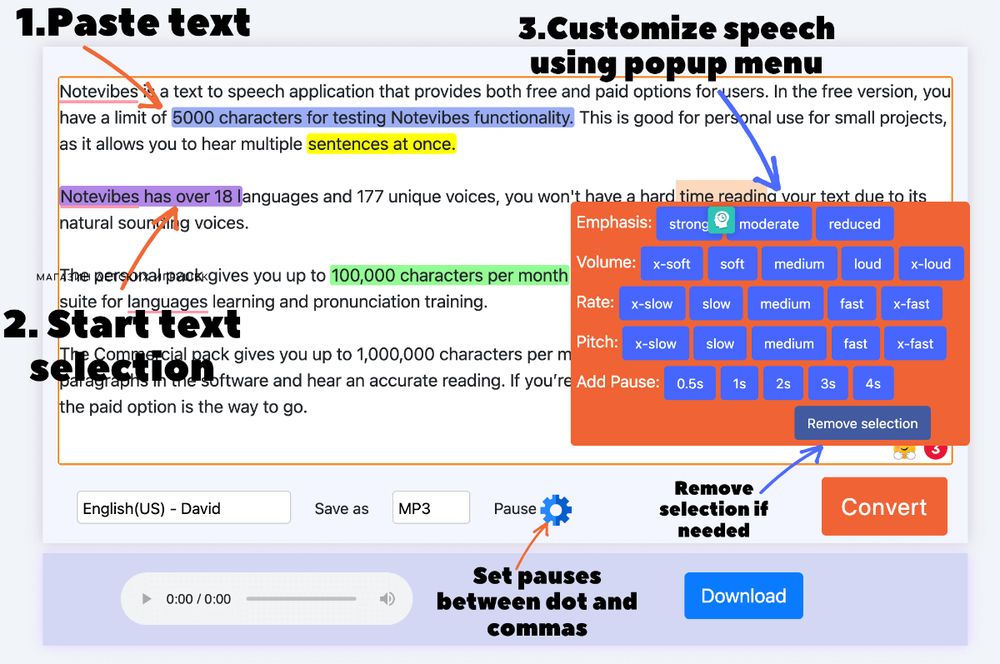

#AI TEXT TO VOICE WINDOWS#
Provision Windows and Linux virtual machines in secondsĮnable a secure, remote desktop experience from anywhere
#AI TEXT TO VOICE ISO#
#You can find the list of language ISO codes () and learn about the Fairseq models ().Explore some of the most popular Azure products #For these models use the following name format: `tts_models//fairseq/vits`. #Example text to speech using **Fairseq models in ~1100 languages** 🤯. tts_to_file( text = "This is a test.", file_path = OUTPUT_PATH, emotion = "Happy", speed = 1.5) # Run TTS with emotion and speed control tts. tts_to_file( text = "This is a test.", file_path = OUTPUT_PATH) # Init TTS with the target studio speaker tts = TTS( model_name = "coqui_studio/en/Torcull Diarmuid/coqui_studio", progress_bar = False, gpu = False) # The name format is coqui_studio/en//coqui_studio models = TTS(). # If you have a valid API token set you will see the studio speakers as separate models in the list. # You should set the `COQUI_STUDIO_TOKEN` environment variable to use the API token. # You can use all of your available speakers in the studio. # Example text to speech using () models. "Wie sage ich auf Italienisch, dass ich dich liebe?", tts = TTS( "tts_models/de/thorsten/tacotron2-DDC") This way, you can # clone voices by using any model in 🐸TTS. # Example voice cloning by a single speaker TTS model combining with the voice conversion model. voice_conversion_to_file( source_wav = "my/source.wav", target_wav = "my/target.wav", file_path = "output.wav") # Example voice conversion converting speaker of the `source_wav` to the speaker of the `target_wav` tts = TTS( model_name = "voice_conversion_models/multilingual/vctk/freevc24", progress_bar = False, gpu = True) tts_to_file( "Isso é clonagem de voz.", speaker_wav = "my/cloning/audio.wav", language = "pt-br", file_path = "output.wav") tts_to_file( "C'est le clonage de la voix.", speaker_wav = "my/cloning/audio.wav", language = "fr-fr", file_path = "output.wav") tts_to_file( "This is voice cloning.", speaker_wav = "my/cloning/audio.wav", language = "en", file_path = "output.wav") # Example voice cloning with YourTTS in English, French and Portuguese tts = TTS( model_name = "tts_models/multilingual/multi-dataset/your_tts", progress_bar = False, gpu = True) tts_to_file( text = "Ich bin eine Testnachricht.", file_path = OUTPUT_PATH) # Running a single speaker model # Init TTS with the target model name tts = TTS( model_name = "tts_models/de/thorsten/tacotron2-DDC", progress_bar = False, gpu = False) tts_to_file( text = "Hello world!", speaker = tts. tts( "This is a test! This is also a test!!", speaker = tts. # Run TTS # ❗ Since this model is multi-speaker and multi-lingual, we must set the target speaker and the language # Text to speech with a numpy output wav = tts. api import TTS # Running a multi-speaker and multi-lingual model # List available 🐸TTS models and choose the first one model_name = TTS. If you are only interested in synthesizing speech with the released 🐸TTS models, installing from PyPI is the easiest option.įrom TTS. You can also help us implement more models.
#AI TEXT TO VOICE CODE#
Modular (but not too much) code base enabling easy implementation of new ideas.Tools to curate Text2Speech datasets under dataset_analysis.Efficient, flexible, lightweight but feature complete Trainer API.Detailed training logs on the terminal and Tensorboard.Vocoder models (MelGAN, Multiband-MelGAN, GAN-TTS, ParallelWaveGAN, WaveGrad, WaveRNN).




 0 kommentar(er)
0 kommentar(er)
